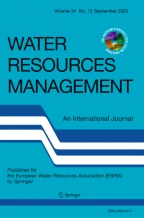Abstract
Automated computation of hydrological and morphometric parameters of any watershed are not only depended on Digital Elevation Model (DEM) resolution but also affected by their sources and drainage Area Threshold Value (ATV). In present study, the effects of different resolution of freely available DEMs are analysed in QSWAT model at different ATVs. The performance of QSWAT model and processing time were also evaluated. DEM derived from ASTER, CARTOSAT and SRTM were used at 30, 90 and 180 m spatial resolutions with six different ATV’s, in QSWAT model. Result shows that DEM resolutions and ATVs have significant impacts on hydrological and morphometric parameters. QSWAT output like sub-basin count and surface runoff were less impacted by DEM resolutions while these components were affected by ATV, while HRU counts and sediment yield were affected by DEM resolution. It was also observed that fine resolution DEM increases processing time at smaller threshold values as compared to coarser resolution DEM. Result of this study could be used for selection of optimum DEM resolution and ATV.
Similar content being viewed by others
References
Abbaspour KC (2011) SWAT-CUP4: SWAT Calibration and Uncertainty Programs A User Manual. EAWAG Swiss Federal Institute of Aquatic Science and Technology:1–103
Arnold JG, Srinivasan R, Muttiah RS, Williams JR (1998) Large area hydrologic modeling and assessment part I: Model development. J Am Water Resour Assoc 34:73–89
Arnold et al (2015) Hydrological Processes and Model Representation: Impact of Soft Data on Calibration. American Society of Agricultural and Biological Engineering 58(6):1637–1660
Ariza-Villaverde AB, Jiménez-Hornero FJ, Gutiérrez de Ravé E (2015) Influence of DEM resolution on drainage network extraction: A multifractal analysis. Geomorphology 241:243–254
Buakhao W, Kangrang A (2016) DEM Resolution Impact on the Estimation of the Physical Characteristics of Watersheds by Using SWAT. Advances in Civil Engineering
Chaubey I, Cotter AS, Costello TA, Soerens TS (2005) Effect of DEM data resolution on SWAT output uncertainty. Hydrol Process 19:621–628
Chandra P, Patel PL, Porey PD, Gupta ID (2014) Estimation of sediment yield using SWAT model for Upper Tapi basin. ISH Journal of Hydraulic Engineering 20(3):291–300
Chaplot V (2005) Impact of DEM mesh size and soil map scale on SWAT runoff, sediment, and NO3–N loads predictions. J Hydrol 312:207–222
Dagguptai et al (2015) Impact of model development, calibration and validation decisions on hydrological simulations in West Lake Erie Basin. Hydrol Process 29(26):5307–5320
Drisya J, Kumar DS (2016) Comparison of digitally delineated stream networks from different space borne digital elevation models: A case study based on two watersheds in South India. Arab J Geosci 9:710
Ehsani AH, Quiel F, Malekian A (2010) Effect of SRTM resolution on morphometric feature identification using neural network—self organizing map. Geoinformatica 14:405–424
Gopinath G, Swetha TV, Ashitha MK (2013) Automated extraction of watershed boundary and drainage network from SRTM and comparison with Survey of India toposheet. Arab J Geosci
Li J, Wong David WS (2010) Effects of DEM sources on hydrologic applications. Comput Environ Urban Syst 34:251–261
Lin et al (2013) Evaluating DEM source and resolution uncertainties in the Soil and Water Assessment Tool. Stoch Env Res Risk A 27:209–221
Munoth P, Goyal R (2019) Impacts of land use land cover change on runoff and sediment yield of Upper Tapi River Sub-basin. India Intl J River Basin Management. https://doi.org/10.1080/15715124.2019.1613413
Mukherjee et al (2013) Evaluation of vertical accuracy of open source Digital Elevation Model (DEM). Int J Appl Earth Obs Geoinf 21:205–217
Rawat et al (2014) Effect of DEM data resolution on low relief region sub-watershed boundaries delineating using of SWAT model and DEM derived from CARTOSAT-1 (IRS-P5), SRTM and ASTER. Journal of Applied and Natural Science 6(1):144–151
Reddy AS, Reddy MJ (2015) Evaluating the influence of spatial resolutions of DEM on watershed runoff and sediment yield using SWAT. J Earth Syst Sci 124(7):1517–1529
Sharma A, Tiwari KN (2014) A comparative appraisal of hydrological behavior of SRTM DEM at catchment level. J Hydrol 519:1394–1404
Tarboton DG, Bras RL, Rodriguez II (1992) A physical basis for drainage density. Geomorphology 5(1/2):59–76
Tan et al (2015) Impacts of DEM resolution, source, and resampling technique on SWAT-simulated streamflow. Appl Geogr 63:357–368
Wu S, Li J, Huang GH (2008) A study on DEM-derived primary topographic attributes for hydrologic applications: Sensitivity to elevation data resolution. Appl Geogr 28:210–223
Wu M, Shi P, Chen A, Shen C, Wang P (2017) Impacts of DEM resolution and area threshold value uncertainty on the drainage network derived using SWAT. Water SA 43(3):450–462
Xu F, Dong G, Wang Q, Liu L, Yu W, Men C, Liu R (2016) Impacts of DEM uncertainties on critical source areas identification for nonpoint source pollution control based on SWAT model. J Hydrol. https://doi.org/10.1016/j.jhydrol.2016.06.019
Zhang P, Liu R, Bao Y, Wang J, Yu W, Shen Z (2014) Uncertainty of SWAT Model at different DEM resolutions in a large mountainous watershed. Water Res 53:132–144
Acknowledgments
Authors are thankful to National Remote Sensing Centre ISRO (BHUVAN Portal), India for providing CARTOSAT data and USGS for providing ASTER and SRTM data. Authors would also like to thanks Ministry of Human Recourses Govt. of India, for providing scholarship to first author.
Author information
Authors and Affiliations
Corresponding author
Ethics declarations
Conflict of Interest
None.
Additional information
Publisher’s Note
Springer Nature remains neutral with regard to jurisdictional claims in published maps and institutional affiliations.
Rights and permissions
About this article
Cite this article
Munoth, P., Goyal, R. Effects of DEM Source, Spatial Resolution and Drainage Area Threshold Values on Hydrological Modeling. Water Resour Manage 33, 3303–3319 (2019). https://doi.org/10.1007/s11269-019-02303-x
Received:
Accepted:
Published:
Issue Date:
DOI: https://doi.org/10.1007/s11269-019-02303-x
